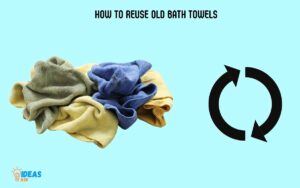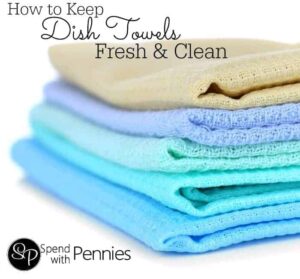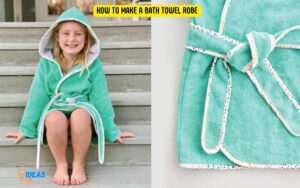How to Remove Lint from New Bath Towels
New bath towels are an essential for any household, but lint can be a problem. Here is a guide on how to remove lint from new bath towels so you can enjoy them for years to come. First, soak the towel in vinegar water for 30 minutes before washing it.
This will help break down the fabric and loosen the fibers. Next, wash the towel in hot water with a mild detergent. Be sure to use a lint-free cycle if your washing machine has one.
Finally, dry the towel on low heat or hang it to air dry.
- Before using your new bath towels for the first time, wash them in warm water with a mild detergent
- Once they are washed, dry them completely in the dryer on a low heat setting
- After they are dried, take each towel and give it a good shake to remove any excess lint
- If there is still lint remaining on the towels, you can try lightly running a lint roller over them or using a dampened cloth to remove it
How Do You Get Fuzz off New Towels?
If you’re like most people, you probably love the feeling of a new towel. But sometimes, new towels can come with a bit of fuzz or lint. Here’s how to get rid of it so you can enjoy your new towel to the fullest!
The first thing you need to do is make sure your towel is dry. Wet towels are more likely to attract and hold onto fuzz and lint. Once your towel is dry, give it a good shake or pat it down with your hand to loosen any loose fibers.
If there’s still some fuzz on your towel, try using a lint roller or tape. Start at one end of the towel and roll or wrap the tape around in long strokes until all the fuzz is gone. If this doesn’t work, dampen a clean cloth with water and gently rub it over the fuzzy areas.
The wetness will help loosen any stubborn fibers so they can be removed easily.
Once you’ve gotten rid of all the fuzz, make sure to wash your towel before using it again. This will remove any residual fibers and make sure your towel stays soft and free of lint for future use!
Should You Wash New Towels before You Use Them?
Yes, you should wash new towels before using them. Although they may appear clean, towels are often covered in dust and other particles from the manufacturing process. Washing them will remove any lingering dirt and ensure that they’re truly clean before you use them.
Additionally, washing new towels will help to soften them up. This is especially important if you’re planning on using them for bathing, as they’ll be more absorbent after being washed. Overall, taking the time to wash your new towels before using them is well worth it!
How to stop towels from shedding | New Vera Wang Towels | Kohl’s Towels
Bath Towel Leaves Lint on Body
If you’ve ever noticed small pieces of lint on your body after using a bath towel, you’re not alone. Many people experience this phenomenon, and it’s perfectly normal. So what causes it?
Basically, when you use a bath towel to dry off your body, some of the fibers from the towel become detached and cling to your skin. These fibers can be made of different materials, including cotton, linen, or microfiber.
One theory is that the static electricity generated by rubbing your skin with the towel causes the fibers to stick.
Another possibility is that the heat from your body helps those fibers bond to your skin. Either way, it’s harmless and nothing to worry about.
If you’d like to avoid getting lint on your body after bathing, there are a few things you can do.
Try using a different type of towel, such as a cotton one instead of a microfiber one. You can also try dampening your towel before using it, which will help reduce static electricity.
Baking Soda to Remove Lint from Towels
If you’ve ever had a linty towel, you know how frustrating it can be. Lint can make your towels less absorbent and cause them to feel scratchy. Fortunately, there’s an easy way to remove lint from towels – and all you need is some baking soda!
To use baking soda to remove lint from towels, simply add 1/2 cup of baking soda to your washing machine along with your regular detergent. Run the cycle as usual, and your towels should come out looking and feeling like new!
If you have particularly lint-prone towels, you may want to pre-treat them with a mixture of 1 part vinegar and 2 parts water before laundering them with the baking soda.
This will help break down any build-up that may be causing the towel to produce more lint.
Happy laundry day!
How to Get Rid of Lint on Black Towels
If you’ve ever washed a black towel and found it covered in lint, you know how frustrating it can be. Luckily, there are a few simple steps you can take to get rid of that pesky lint and keep your towels looking like new.
First, make sure you’re using a good quality lint brush.
A cheap one will likely just spread the lint around, making the problem worse. Second, use a back and forth motion when brushing the towel – don’t go in circles as this will also cause the lint to spread. Finally, rinse the towel off with cold water after brushing to remove any loose fibers.
With these tips in mind, you’ll be able to quickly and easily remove lint from your black towels – keeping them looking fresh and new for longer!
How to Remove Lint from Towels Without a Dryer
If you’ve ever washed a load of laundry only to find that your towels are covered in lint, you know how frustrating it can be. Thankfully, there’s an easy way to remove lint from towels without using a dryer. Here’s what you need to do:
1. Start by wetting the towel that you want to de-lint. You can do this by running it under the faucet or soaking it in a sink full of water.
2. Once the towel is wet, Wring it out so that it’s not dripping wet but still damp.
3. Next, take a pair of scissors and cut off any loose threads or fabric that is hanging off of the towel. This will help prevent the lint from getting worse.
4. Now, lay the damp towel flat on a surface like a table or countertop.
Make sure there are no wrinkles in the towel so that the lint has nowhere to hide!
5 Using your hands or a brush, gently rub the towel in circular motions until all of the lint has been removed.
Washing New Towels With Salt
If you’re like most people, you probably think of salt as something that you use to add flavor to your food. But did you know that salt can also be used for cleaning? That’s right – salt is a natural disinfectant and can be used to cleanse and purify your home.
One of the best ways to use salt for cleaning is to wash new towels with salt. This will help remove any unwanted chemicals or residues that may be on the towel from the manufacturing process. It’s also a great way to keep your towels looking and smelling fresh.
Here’s how to do it: simply add 1/2 cup of salt to your washing machine along with your regular detergent. Wash the towels on a hot cycle and then rinse well. You’ll notice that your towels are softer and fluffier than ever before!
How to Break in New Towels
If you’ve ever had the experience of using a new towel and feeling like you’re being scratched by sandpaper, you know how frustrating it can be. Breaking in new towels doesn’t have to be so painful, though. With a little care and effort, you can make your new towels soft and comfortable in no time.
Here are a few tips for breaking in new towels:
– Wash them before using. This will help to remove any manufacturing chemicals or residue that may be present on the towel.
Be sure to use a mild detergent and avoid fabric softeners, which can actually make towels less absorbent.
– Use them frequently. The more often you use your towels, the softer they’ll become.
If possible, try to use them daily until they reach the desired level of softness.
– Give them a good scrub. Once your towels are wet, give them a good scrub with your hands or a washcloth.
This will help to loosen up the fibers and make the towel more absorbent. Avoid using scrubbing brushes or other rough materials, as this could damage the towel’s fibers.
– Hang them up to dry properly .
Wet towels should always be hung up to dry , never left in a heap on the floor . This will help to prevent mildew growth and keep your towels looking their best .
New Towels Shedding Reddit
If you’ve ever bought a new towel and found it to be shedding a lot of lint, you’re not alone. It’s a common problem that many people have faced, but there are ways to avoid it.
First, make sure you’re buying quality towels.
They may cost a bit more, but they’ll last longer and shed less. Second, wash your towels before using them for the first time. This will help remove any manufacturing residue that could be causing the shedding.
Finally, use a lint roller or tape to remove any loose fibers from your towel before using it. This will help keep the shedding to a minimum. With these tips in mind, you can enjoy your new towels without having to deal with too much lint!
Washing New Towels With Vinegar And Baking Soda
If you’re like most people, you probably think of vinegar and baking soda as nothing more than household cleaning supplies. But did you know that these two simple ingredients can also be used to wash new towels? That’s right – vinegar and baking soda can help remove any residual chemicals or odors from your new towels, leaving them feeling soft, fresh, and clean.
Here’s how to do it:
Start by adding 1/2 cup of vinegar and 1/4 cup of baking soda to a large bucket or sink full of warm water. Then, add your new towels and let them soak for 30 minutes.
After the 30 minutes are up, simply launder your towels as usual – there’s no need to rinse out the vinegar or baking soda beforehand. You’ll be amazed at how much fresher and softer your towels feel after just one wash!
Conclusion
Lint is one of those things that seems to appear out of nowhere. It’s especially prevalent with new bath towels, which can be a real nuisance. If you’re looking for a way to get rid of lint, there are a few things you can try.
One option is to use fabric softener sheets. Simply run the sheet over the towel and it will help to loosen and remove the lint. You can also try using vinegar.
Soak the towel in a mixture of 1 part vinegar to 3 parts water for about 30 minutes. This will help to break down the fibers and make it easier to remove the lint.
If you’re still having trouble, you can always take it to a laundromat and have them run it through an extra cycle or two.
This should do the trick!





